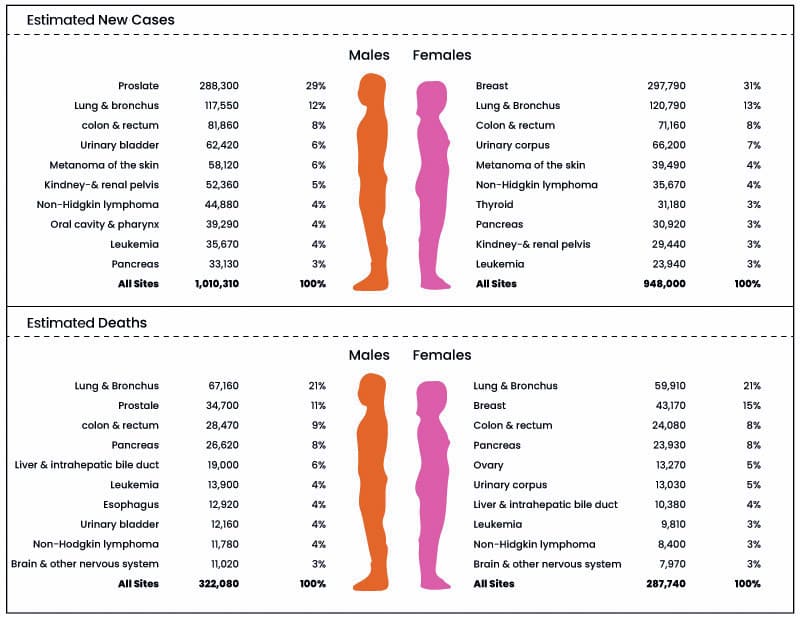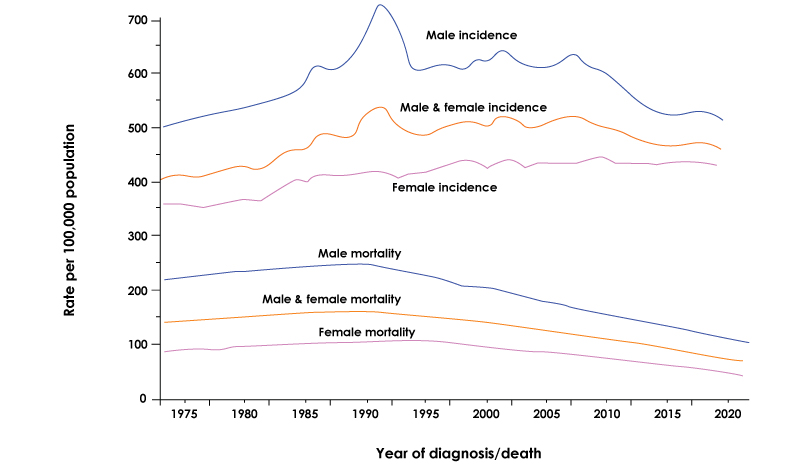Cancer is the leading cause of death at the global level. The global war against cancer is not a new one. It has been going on for decades now. The global objective to fight and win over cancer is so strong that everyone, from researchers to scientists, is collaborating tirelessly to end this worldwide burden.
Introduction
The field of computer science has shown remarkable and promising results in the past in this battle against cancer. Growing expenditure directed towards the research and development proficiencies involving the application of computer science in cancer diagnosis and treatment is a positive sign for the global healthcare industry. But before understanding the role of computer science in oncology, let us look at the recent global cancer statistics.

Fig.1: Cancer Statistics 2023 (U.S.)
Source: Cancer.org
The most typical cancer diagnoses for men and women in 2023 are shown in Figure 1. Nearly half (48%) of all incident instances of cancer in males are for the prostate, lung, and bronchus (hereafter lung), and colorectal cancers (CRCs), with 29% of diagnoses coming from prostate cancer alone. Breast cancer alone accounts for 31% of all cancer diagnoses in women, whereas lung cancer, CRC, and breast cancer together account for 52% of all new diagnoses. The projected number of new cases and fatalities from the top ten cancer types in the United States by sex in 2023. Estimates are rounded to the closest 10, and cases don't include in situ cancers of the urinary bladder or basal and squamous cell skin cancers.

Fig.2: Trends in Cancer Incidence (1975–2019) and Mortality (1975–2020) Rates by Sex (U.S.)
Source: Cancer.org
Figure 2 depicts long-term trends in overall cancer incidence rates, which reflect patterns in cancer-risk behaviors and changes in medical practice, such as cancer screening tests. For isntance, the early 1990s spike in male incidence reflects a surge in the detection of asymptomatic prostate cancer as a result of widespread rapid uptake of prostate-specific antigen (PSA) testing among previously unscreened men. After that, men cancer incidence decreased until around 2013, then stabilized until 2019. Women's rates were relatively stable until the mid-1980s when they began to rise slowly by 0.5% per year.
As a result, the gender gap is gradually closing, with the male-to-female incidence rate ratio falling from 1.59 (95% CI, 1.57-1.61) in 1992 to 1.14 (95% CI, 1.14-1.15) in 2019. However, risk differences vary greatly by age. For instance, females have about 80% higher rates than males between the ages of 20 and 49, while men have nearly 50% higher rates between the ages of 75 and older.
C & CSc: Cancer and Computer Science
These figures not only highlight the dreadful reality of this prevalent illness but are also crucial for academics, policymakers, and other professionals since they must first comprehend the effects cancer has on the global population before coming up with measures to fight it.
A startling call to action to an unlikely pool of candidates—computer scientists—is among those recently offered techniques. These recent advancements in the battle against cancer have the potential to fundamentally alter the research landscape for that field and, ultimately, save thousands of lives. This is but one potential method by which computer science could harvest big data to progress the sciences as a whole seriously.
Siddhartha Mukherjee, an Indian-born American physician and scientist, writes in his book The Emperor of All Maladies: A Biography of Cancer about the startlingly recent finding that cancer is a hereditary disease predominantly brought on by mutations in our DNA. So, due to these mutations, cancer tumors have an inconceivable diversity that makes them challenging to eradicate entirely.
As a result, it has been suggested that by sequencing the genome of a cancer tumor, which is essentially the process of translating or decoding the enigmatic language that makes up the tumor's unique DNA sequence, doctors will then be able to prescribe individualized, targeted treatment for each cancer patient with the aim of either stopping the cancer's growth or curing it completely.
Computer scientists such as David Patterson, one of the directors of the Algorithms, Machines, and People Laboratory (AMP Lab) at UC Berkeley, has been motivated by this in their work. The human eye cannot possibly do such a task by itself. To correctly and successfully absorb and analyze this huge volume of data at breakneck speed would require the engagement of some of the most potent cognitive computing platforms in the world, such as IBM's Watson. There will be three outcomes from computer scientists' involvement in this highly technological process:
-
Lowering information processing costs can help make tailored treatment accessible to everybody
-
It might lead to developing a cancer genome repository accessible to researchers and medical experts
-
It will be able to find a tiny needle in a very large haystack by using the aforementioned repository to find individualized, targeted therapy for each unique tumor among the countless possible drug combinations
Computational Oncology as an Extension to Computer Science in Oncology
Computational biology forges a connection between physical science and oncology. Computational oncology is a relatively new term in medicine that is starting to acquire traction. Some people might be surprised to learn that huge medical institutions all over the world are creating complete departments labeled as such. More and more time, effort, money, and resources are being devoted to learning how cancer spreads and can ultimately be permanently removed from the body.
With everything, the likelihood of developing long-lasting solutions increases with the information gathered. In order to organize tumor growth pathways, tumor biology, bioinformatics, and tumor marker profiles and construct predictive models for treatments based on all of this data, computational oncology organizes the molecular aspects of cancer.
Computer models are used in computational oncology to produce tumor marker analytics that are helpful in, precision medicine, population screening, and individual cancer cell modeling. This knowledge makes it more likely that specific medications or treatment techniques will offer long-term remedies for disease in a person with cancer.
For many years-and in certain circumstances, even today-the majority of people with cancer have received treatment that is only "broadly applied." When molecular markers are absent or less useful in determining the precise reasons why particular treatment approaches are effective for some patients but not others. In order to better serve patients, computational oncology departments can take the wealth of information about our genome that next-generation sequencing (NGS) has made available in both healthy and diseased cells and organize it into a database.
To manage all facets of this emerging field of medicine, some departments look for people with skill sets in either computer science or laboratory science. For educators, scientists, and clinicians, this field is expanding. By working together, we can increase our knowledge and skills in order to lessen the burden of cancer around the world, which is predicted to increase from 14.1 million new cases in 2012 to 23.6 million cases annually by 2030, according to the International Agency for Research on Cancer.
Data Bridge Market Research analyses that the cancer diagnostics market is expected to reach the value of USD 28.21 billion by the year 2029, at a CAGR of 7.29% during the forecast period. North America dominates the cancer diagnostics market due to the increasing presence of numerous biotechnology and medical device companies, increased funding available for research and development projects, and the region's high adoption of advanced technologies. Some of the major players operating in the cancer diagnostics market are Abbott. (U.S.), DiagnoCure Inc. (Canada), Thermo Fisher Scientific Inc. (U.S.), Illumina, Inc. (U.S.), QIAGEN (Germany), and F. Hoffmann-La Roche Ltd (Switzerland).
To know more about the study, visit: https://www.databridgemarketresearch.com/reports/global-cancer-diagnostics-market
‘‘Microsoft’s a Decade Long Ambition”
Microsoft is utilizing computer science, including machine learning and algorithms, to battle cancer. Microsoft researchers can modify techniques generally used to model computational processes to simulate biological ones by approaching cancer like an information processing system.
The company's ultimate goal is to develop molecular computers that will instruct the body to combat cancer cells as soon as they are discovered. Combining this with a data-driven strategy, Microsoft's efforts to combat the disease center on machine learning. The business hopes to employ analysis tools to take the existing biological data and use it to understand better and treat the disease.
It's a profound mathematical discovery, not merely an analogy. While biology and computing may appear like poles apart, they actually have very deep ties at the most fundamental level. For instance, machine learning and natural language processing are being utilized to provide a method for sorting through the available research data, which can then be supplied to oncologists to produce the most effective and customized cancer treatment for patients.
Currently, so much information is available that it is hard for one individual to read through it all and comprehend it. Information can be processed more quickly and simply by machine learning than humans.
Machine learning is also combined with computer vision to help radiologists better comprehend how a patient's tumor is developing. Researchers are developing a system that, in the future, will analyze pixels from 3D scans to determine exactly how much a tumor has grown, decreased, or changed shape since the previous scan. According to Andrew Phillips, head of the Cambridge Lab's biological computation research division, scientists can learn from Microsoft's legacy as a pioneer in the software industry. "We can program biology using techniques we've discovered for programming computers," he added. "This will open up far more uses and even better treatments."
Phillips is developing a molecular computer that may be inserted within a cell to track for sickness. A response to combat the disease would be triggered if the sensor discovered it to be anything like cancer. This type of research would also employ conventional computing and repurpose it for use in biotechnology or medical applications, enabling the body to be trained to combat sickness in the same manner that we program computers to do so.
Although the research is still in its early phases, Phillips told The Telegraph that in "five to ten 'years' time," it would be technically feasible to implant a smart molecular system to combat a disease in this manner.
Conclusion
Cancer research is increasingly being conducted online. Computer scientists should enlist in droves since they may have the best talent to combat cancer in the next ten years. It is hoped that by sequencing a cancer tumor's genome, medical professionals may soon be able to provide a customized, targeted therapy to slow or stop the spread of cancer.
Given how quickly computer science has impacted patient lives and integrated into cancer research, it seems reasonable to predict that the coming years will be equally, if not more, productive. Over the following ten years, it is anticipated that medical practitioners will be able to create detailed maps of how healthy and sick tissues develop and evolve. These maps will help them design new cancer diagnostics and treatments.
Data Bridge Market Research analyses that the artificial intelligence in healthcare market, which is USD 9.64 billion in 2022, is expected to reach USD 272.91 billion by 2030, at a CAGR of 51.87% during the forecast period 2023 to 2030. The artificial intelligence in healthcare market is segmented on the basis of offering, technology, end-user, and application. Asia-Pacific is expected to grow at the highest growth rate in the forecast period of 2023 to 2030 due to the increase in government initiatives to promote awareness, rise in medical tourism, and the growing demand for quality healthcare in the region.
To know more about the study, visit: https://www.databridgemarketresearch.com/reports/global-artificial-intelligence-in-healthcare-market









